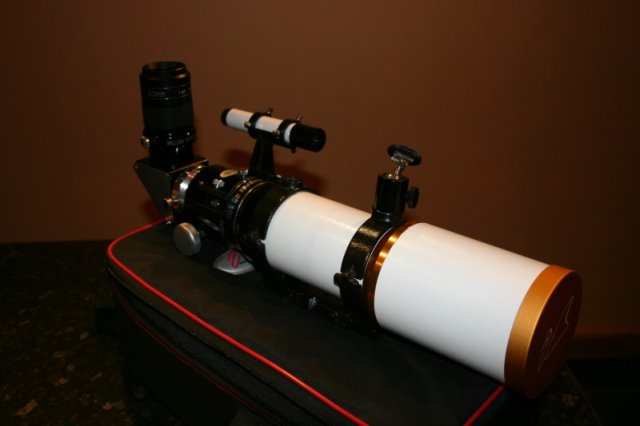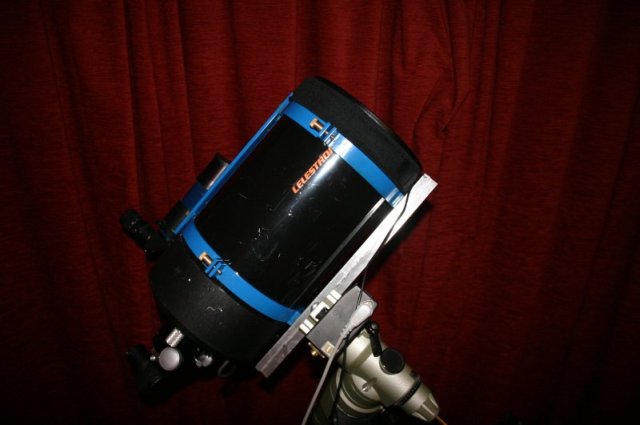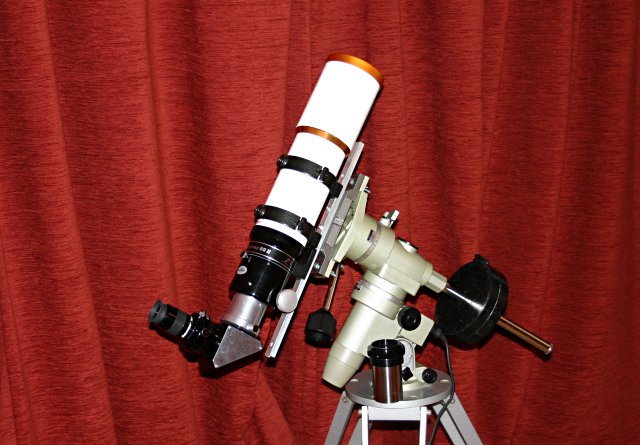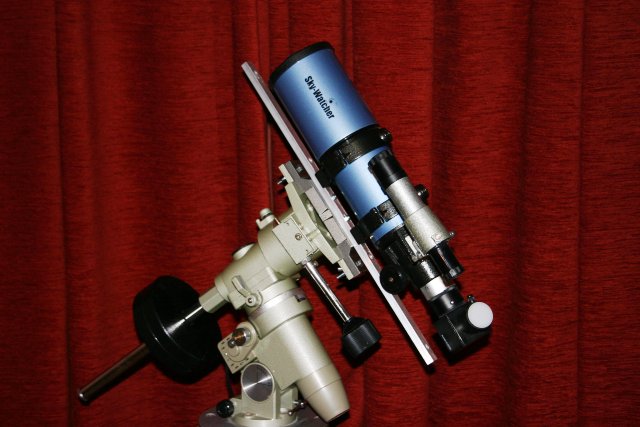| Telescopes |
| HOME Best Lunar Planets Deepsky Misc Equipment Techniques Links |
| Cameras Telescopes Filters |
|
When capturing the images on these pages, I have used several telescopes. From large to small, different telescopes have different uses, and I have progressed through a variety.
Although I now have a large (for low-budget amateur astronomy) telescope and a small one, I am not sure whether I have settled down with my permanent scopes, but it will remain stable for a while!
Here are pictures and detail of the telescopes I have been using. |
||||||
|
Current Deep-Sky Imaging Set-Up with Guiding Main Purpose: DSO Imaging with Atik CCD camera or DSLR | ||||||
| ||||||
| to top | ||||||
| Megrez 80 Triplet Super Apo Telescope
Main Purpose: Deep-Sky imaging Secondary Purpose: Lunar disk imaging 
|
||||||
|
I have now replaced my Megrez 80IISD (see below) with an improved version - the Megrez 80 Triplet Super Apo. This telescope has a much better lens than the older one. It is apochromatic, which means that all three primary colours (red/green/blue) are brought to focus at exactly the same point (within tolerance). This means that the images and eyepiece views through this telescope are much better and don't suffer from coloured fringes at the edge of bright objects, or blue rings around stars, caused largely by differing focus positions of the colours.
In this photo you can see the telescope on it's bag. The fitting on top of the front ring is a threaded bracket for mounting a camera. The telescope has a diagonal and a 2" eyepiece in its focuser. | ||||||
| to top | ||||||
| Celestron C8 200mm Schmidtt-Cassegrain Telescope
Main Purpose: Planetary and Lunar imaging Secondary Purpose: Smaller DSO imaging 
|
||||||
|
After a couple of years I replaced my Europa 250 with this 8" Celestron SCT (Schmidtt Cassegrain Telescope). I just wasn't getting the best out of the Newtonian and it was sensitive to my poor seeing. The Celestron SCTs have a good reputation for planetary imaging and I hope this will serve well.
The telescope is shown here mounted on my Vixen GP-DX mount using custom-made rings and a dovetail by Ray's Rings (http://www.freewebs.co.uk/raysrings). | ||||||
| to top | ||||||
| William Optics Megrez 80 II SD 80mm f/6.25 Refractor
Main Purpose: DSO prime-focus imaging with Canon DSLR Secondary Purpose: Guiding main scope (as yet unachieved) 
|
||||||
|
This refractor is very similar in size to the Skywatcher below, and it was in fact purchased as a replacement for that telescope. It has the same diameter objective lens (80mm) and a slightly longer focal length (500mm instead of 400) giving almost the same field of view. The difference is the quality of this telescope, which is far higher. The image quality is better, and the overall build quality of this telescope is superior. The focusser is much better too, being a two-inch type (rather than 1.25) and it's of the Crayford design rather than ordinary rack-and-pinion. The focuser is rotatable too, allowing me to rotate the camera without losing focus position. It is shown here with a Celestron 32mm 1.25" eyepiece inserted via the William Optics 2" diagonal. The object placed on the tripod next to the mount is a 2" camera mount with a T2 thread.
Like the ST80 below, I mount it on the Vixen SP mount and capture deep-sky and lunar images with the Canon EOS300D camera. | ||||||
| to top | ||||||
| Skywatcher 80mm f/5 Refractor
Main Purpose: DSO prime-focus imaging with Canon DSLR Secondary Purpose: Guiding main scope (as yet unachieved) 
|
||||||
|
I bought this small refractor with several purposes in mind: As a wide-field scope; As a small scope for suitable for travelling with; and possibly to guide the main telescope mount for long exposures - this is still reserved as a future project.
Mounted on the same mount as the main telescope (although not at the same time), it has been very useful for deep-sky pictures with the Canon EOS300D digital SLR camera. The low focal ratio makes it good for picking up dim objects, and the consequentially short focal length means that the field-of-view is wide enough for some of the larger objects. For example, M31, the Andromeda Galaxy, fits into a single frame of the EOS300D with this telescope. The only reservations of this telescope are: 1. It is Achromatic, making images susceptible to colour fringing; and 2. The curved field suffers from coma (distortion) around the edges of the large DSLR frame. | ||||||
| to top | ||||||
|
Orion (UK) Europa 250mm f/4.8 Reflecting Telescope Main Purpose: Lunar and Planetary Imaging with webcam and 2x Barlow or 5x PowerMate Secondary Purpose: DSO prime-focus Imaging with modified webcam or DSLR | ||||||
| ||||||
| to top | ||||||
| Astro Systems 216mm f/5 reflecting Telescope Main Purpose: Lunar and Planetary Imaging with webcam and 2x Barlow lens Secondary Purpose: DSO prime-focus Imaging with modified webcam | ||||||
| ||||||
| to top | ||||||
| Vixen SP Equatorial Mount | ||||||
| to top | ||||||
| Meade EQ1-B 114mm Reflecting Telescope Main Purpose: Lunar and Planetary Imaging with webcam and 2x Barlow Secondary Purpose: Solar imaging with full-aperture solar film filter (See Venus Transit 2004) | ||||||
| to top | ||||||
| A closer view | ||||||
| ||||||
| to top | ||||||
| Finders | ||||||
| to top | ||||||
 |
||||||
| All text and images copyright and may not be used without permission |
||||||